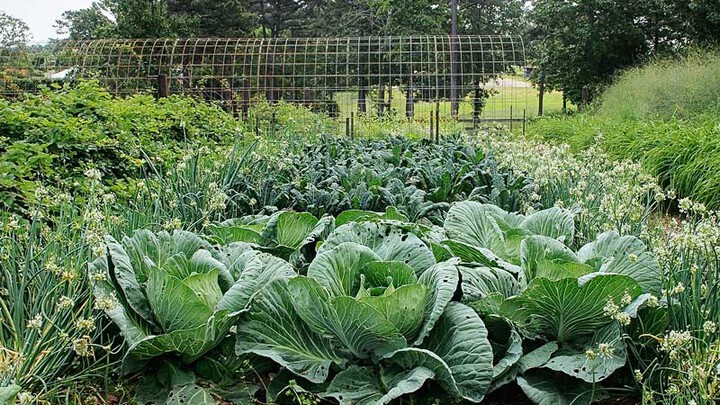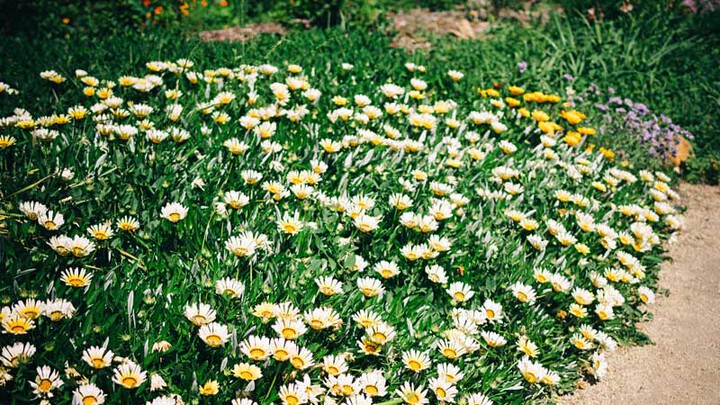When it comes to planning and executing a garden, the limitless array of options can be overwhelming. From water-wise landscapes to edible planting beds, there’s a lot to consider: designs that fit best with your lifestyle, varieties that thrive most in your climate, and watering systems that make sense for the space. To help, we break down three types of gardens that not only beautify your outdoor spaces, but also benefit the local ecosystem.
1.Native Perennial Gardens
2.Vegetable Gardens
3.Pollinator-Friendly Gardens
Native Perennial Gardens
If you want to add color and life to your landscape but don’t want to devote your weekends to planting, pruning, and otherwise maintaining your garden, a native perennial garden is a great choice to consider. Native perennial plants naturally thrive in your environment without all the work of a traditional annual garden. They adapt to your existing soil, survive on the average amount of rainfall your region receives, and provide food and habitat for local species of birds, bees, and other pollinators.
Because they’re perennial, the plants live year after year, requiring only the occasional pruning or dividing to keep them looking good. Easy on a busy schedule and friendly on the wallet, a native perennial garden is a top pick for people who are limited on time or resources.
Good For: Drought-susceptible areas, arid climates, people who want a low-maintenance garden.
Recommended Plants: Because native plants vary by region, the best place to source them is through your local independent garden center, native plant society, or cooperative extension.
Watering Tips: Native plants need little moisture compared to other types of vegetation. However, there may be times when you need to supplement the rainfall in your area during heat spells or support new plantings until they’re established. A Gilmour Flexogen Super Duty Hose with a thumb control watering nozzle works best for occasional watering, but for hands-off convenience, install soaker hoses around trees, shrubs, and plants to irrigate right at the root zone and conserve water.

Vegetable Gardens
If the idea of preparing a meal from your own backyard sounds highly appealing, or you want to save money on organic produce, a vegetable garden is a worthy investment. You’ll spend more time tending to this type of garden by way of weeding, fertilizing, and harvesting, but the rewards are delicious and deeply satisfying. Since vegetable gardens thrive on interaction and regular care, they encourage you to get outside for some fresh air, help you get your daily dose of vitamin D, and promote healthy eating habits.
For a well-balanced garden that supports the local ecosystem (both above and below ground) and gives color throughout the year, aim for a mix of perennial herbs and vegetables (such as rosemary, thyme, artichokes, and asparagus) and annuals (most of the produce you see in the store).
Good For: People who like to cook and want to know where their food comes from.
Recommended Plants: Grow vegetables you like to eat! Best bets for sunny gardens include fruiting plants, such as summer and winter squash, tomatoes, cucumbers, beans, peas, and peppers.
Gardens that are on the shady side (but still have at least six hours of dappled light per day) do well with leafy greens like lettuce, spinach, arugula, and kale, as well as root crops like carrots, beets, turnips, and radishes.
Watering Tips: As a general rule, vegetable gardens need an inch of water per week from rain or irrigation, with more during heat spells or peak summer. For new plantings, keep the first couple inches of soil evenly moist (but not waterlogged) every day to reduce transplant shock. Once the roots become established, switch to a less frequent watering schedule (anywhere from one to three times a week, depending on your soil and climate). Aim to water more deeply to encourage them to grow down, rather than linger near the surface.
Line your garden beds with soaker hoses attached to a watering timer to automate your irrigation and keep the soil consistently moist. Maintaining a steady watering schedule and never letting the soil become too wet or too dry helps prevent plant stress and reduce disease.

Pollinator-Friendly Gardens
Bees, butterflies, and other pollinators play important roles in the garden by pollinating flowers that, in turn, support a healthy ecosystem by cleaning the air, stabilizing soils, and sustaining wildlife. Pollinators also prey on common pests like aphids, which helps maintain the natural balance in your garden without the need for harmful pesticides.
In fact, the majority of our pollinators are not the honeybees we know and love—they’re the lesser known mason bees, parasitic wasps, hoverflies, and moths. Providing a safe source of nectar for them ensures they’ll continue to thrive and do their good work, all while enhancing our spaces at the same time.
Good For: Garden traditionalists, fresh flower enthusiasts, and people who want to help save the pollinators.
Recommended Plants: Grow a variety of nectar-rich plants that bloom at different times of year to ensure a steady food supply: milkweed, coreopsis, bee balm, aster, daisy, coneflower, sunflower, lantana, yarrow, and borage, to name a few. Flowering herbs, like basil, oregano, lavender, rosemary, cilantro, fennel, and dill are also good choices (with edible benefits to boot).
Watering Tips: Create a more efficient garden by planting flowers with similar moisture needs together. Many perennials are drought-tolerant, requiring little water once established, while annuals need a moderate amount of water to stay lush.
To cover a backyard full of blooms, use an elevated sprinkler to gently shower your flowers without knocking them down. For smaller areas, set up a series of mini sprinklers along your flower beds and flower pots to deliver water exactly where needed.